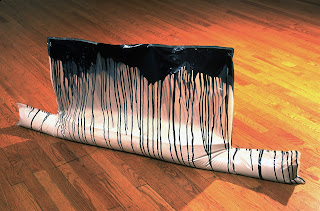In the following two pieces, the plaster structure was cast in holes dug in the ground (accounting for their color and texture). While the plaster was setting, I added the wooden “legs”. The cover is a sewn envelope made of vinyl, reinfored with wire, and held up by a dowel mast.
5) Vinyl, plaster, wood, wire, thread.
32”x36”x6”. 1995
The following piece was made during the same summer as the above two pieces and is both an anomaly as well as a transition to the later work below. It’s become an iconic work for me and informs (and haunts) much of the work that’s come after it.
7) Vinyl, hydrocal, wood, thread.
40”x46”x20”. 1996
Furthering the “slipcover” idea of the previous three pieces, the following five images show work made while in residence at the Sharpe Foundation during 1996-97.
8) Vinyl, hydrocal, thread.
23”x27”x4”. 1997
Evolving out of the above works and moving back onto the wall, the remaining pieces each share the same basic features: A “support” made of horizontally joined sheets of foam insulation, which may or may not then be painted (it is either pink or blue when unpainted); a poured hydrocal form set into the foam surface; a sewn vinyl cover, held away from the surface of the foam by the hydrocal relief, onto which paint may then be variously applied (more thickly in images 13 and 14; more lightly with an air-brush in the others); a hanging system which allows the works to “hover” approximately 2” from the wall. The last piece, made for a show at the Worcester Art Museum, is the largest (almost 9’x17’) and has no painting on the surface of the foam (and just a haze of air-brushed paint on the surface of the vinyl).
13) Foam insulation, hydrocal, vinyl, acrylic paint, thread.
52”x40.5”x6.5”. 1999


















